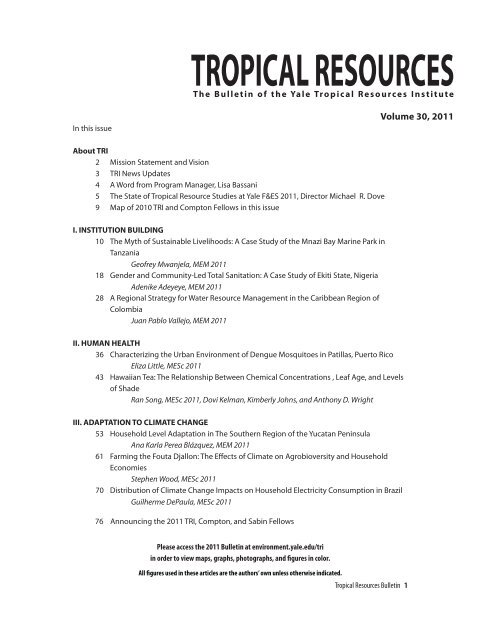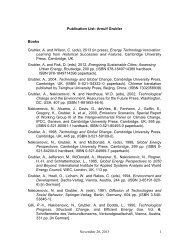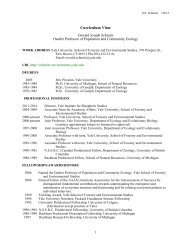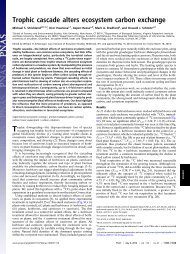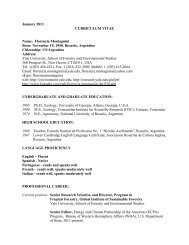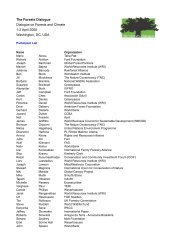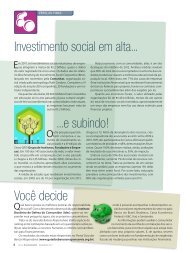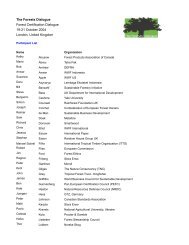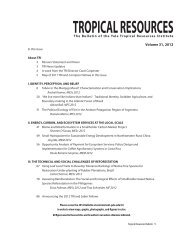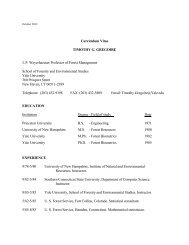TROPICAL RESOURCES - Yale School of Forestry & Environmental ...
TROPICAL RESOURCES - Yale School of Forestry & Environmental ...
TROPICAL RESOURCES - Yale School of Forestry & Environmental ...
You also want an ePaper? Increase the reach of your titles
YUMPU automatically turns print PDFs into web optimized ePapers that Google loves.
In this issue<br />
<strong>TROPICAL</strong> <strong>RESOURCES</strong><br />
The Bulletin <strong>of</strong> the <strong>Yale</strong> Tropical Resources Institute<br />
About TRI<br />
2 Mission Statement and Vision<br />
3 TRI News Updates<br />
4 A Word from Program Manager, Lisa Bassani<br />
5 The State <strong>of</strong> Tropical Resource Studies at <strong>Yale</strong> F&ES 2011, Director Michael R. Dove<br />
9 Map <strong>of</strong> 2010 TRI and Compton Fellows in this issue<br />
I. INSTITUTION BUILDING<br />
10 The Myth <strong>of</strong> Sustainable Livelihoods: A Case Study <strong>of</strong> the Mnazi Bay Marine Park in<br />
Tanzania<br />
Ge<strong>of</strong>rey Mwanjela, MEM 2011<br />
18 Gender and Community-Led Total Sanitation: A Case Study <strong>of</strong> Ekiti State, Nigeria<br />
Adenike Adeyeye, MEM 2011<br />
28 A Regional Strategy for Water Resource Management in the Caribbean Region <strong>of</strong><br />
Colombia<br />
Juan Pablo Vallejo, MEM 2011<br />
II. HUMAN HEALTH<br />
36 Characterizing the Urban Environment <strong>of</strong> Dengue Mosquitoes in Patillas, Puerto Rico<br />
Eliza Little, MESc 2011<br />
43 Hawaiian Tea: The Relationship Between Chemical Concentrations , Leaf Age, and Levels<br />
<strong>of</strong> Shade<br />
Ran Song, MESc 2011, Dovi Kelman, Kimberly Johns, and Anthony D. Wright<br />
III. ADAPTATION TO CLIMATE CHANGE<br />
53 Household Level Adaptation in The Southern Region <strong>of</strong> the Yucatan Peninsula<br />
Ana Karla Perea Blázquez, MEM 2011<br />
61 Farming the Fouta Djallon: The Eects <strong>of</strong> Climate on Agrobioversity and Household<br />
Economies<br />
Stephen Wood, MESc 2011<br />
70 Distribution <strong>of</strong> Climate Change Impacts on Household Electricity Consumption in Brazil<br />
Guilherme DePaula, MESc 2011<br />
76 Announcing the 2011 TRI, Compton, and Sabin Fellows<br />
Please access the 2011 Bulletin at environment.yale.edu/tri<br />
in order to view maps, graphs, photographs, and gures in color.<br />
All gures used in these articles are the authors’ own unless otherwise indicated.<br />
Tropical Resources Bulletin 1<br />
Volume 30, 2011
Household level adaptation in the Yucatan Peninsula<br />
III. ADAPTATION TO CLIMATE CHANGE<br />
Household Level Adaptation in the Southern<br />
Region <strong>of</strong> the Yucatan Peninsula<br />
Ana Karla Perea Blázquez, MEM 2011<br />
Abstract e negative impacts <strong>of</strong> climate change are expected to aect the poorest communities<br />
least able to cope with the increasing alterations in the weather (Huq and Reid 2007). In<br />
Mexico, projections show that the amount <strong>of</strong> total annual rainfall will decrease in many parts<br />
<strong>of</strong> the country towards the end <strong>of</strong> this century (INE-SEMARNAT 2010). One <strong>of</strong> the major<br />
impacts that farmers will face is the changing cycles <strong>of</strong> rain and rainfall patterns that inuence<br />
their crop and harvest success (Jennings et al. 2009).<br />
is research project identies the ongoing adaptation strategies <strong>of</strong> ten small-scale<br />
farming communities in the southern Yucatan Peninsula. e interviews conducted in these<br />
communities show that the predominant strategies are changes in the agricultural calendar,<br />
diversication <strong>of</strong> productive activities, and migration. Delays in the rainfall season may be<br />
critical to the livelihoods <strong>of</strong> families or households dependent on seasonal agriculture. For<br />
that reason, it is important to better understand the existing adaptation mechanisms <strong>of</strong> local<br />
farmers and analyze if these can be complemented with additional adaptation practices and/<br />
or technologies.<br />
Introduction<br />
Impacts associated with climate change are<br />
expected to primarily aect the poorest communities<br />
least able to cope with the increasing alterations<br />
in the weather (Huq and Reid 2007).<br />
Delays in the rainfall season may be critical to<br />
the livelihoods <strong>of</strong> families or households dependent<br />
on seasonal agriculture. In places where<br />
drought is becoming more frequent, farmers<br />
need either to adjust their agricultural practices<br />
to the changing environmental and climate<br />
Ana Karla Perea Blázquez is from Mexico and<br />
holds a BA in <strong>Environmental</strong> Engineering. Before<br />
beginning her Master’s at <strong>Yale</strong>, she worked in<br />
Mexico’s National Forest Commission, managing a<br />
trust fund that nances forestry research projects.<br />
She graduated with a Master <strong>of</strong> <strong>Environmental</strong><br />
Management in May 2011, focusing on climate<br />
change adaptation in Mexico.<br />
conditions (Baas and Ramasamy 2008), look<br />
for o-farm income-generating activities, deintensify<br />
agriculture, or perform a combination<br />
<strong>of</strong> all the above. For that reason, it is important<br />
to better understand the existing adaptation<br />
mechanisms <strong>of</strong> local farmers and analyze if<br />
these can be complemented with other practices<br />
and/or technologies.<br />
During the months <strong>of</strong> May – August 2010,<br />
I worked with the College <strong>of</strong> the Southern<br />
Frontier (ECOSUR) on a project that aims to<br />
identify ongoing adaptation strategies in rural<br />
sector communities <strong>of</strong> the Southern Yucatan<br />
Peninsula. is project was designed as part <strong>of</strong><br />
a larger project that is being conducted between<br />
ECOSUR, Clark University, Rutgers University,<br />
and the University <strong>of</strong> Virginia named “New<br />
Knowledge About Ecosystem-Level Response to<br />
Increased Frequency <strong>of</strong> Large-Scale Natural Dis-<br />
Tropical Resources Bulletin 53
Ana Karla Perea<br />
turbance Driven by Climate Change (EDGY).”<br />
EDGY “seeks to understand the social and ecological<br />
impacts <strong>of</strong> natural disturbances across<br />
the Yucatan Peninsula <strong>of</strong> Mexico” and includes<br />
as one <strong>of</strong> its research objectives learning about<br />
“household responses, social impacts, vulnerability,<br />
and adaptability for maize subsistence<br />
farmers in the region” (EDGY 2010).<br />
My research project describes the<br />
ongoing agricultural adaptation strategies<br />
at the household level in ten small-scale<br />
farming communities in the southern Yucatan<br />
Peninsula. e analysis focused on maize<br />
cultivation because <strong>of</strong> the high cultural and<br />
economic value that it holds for farmers in this<br />
region. e research also addresses the topic<br />
<strong>of</strong> potential drought-adaptation policies and<br />
practices, such as the dissemination <strong>of</strong> improved<br />
weather forecasts, that could be implemented in<br />
the region.<br />
Background<br />
Agriculture is among the most vulnerable<br />
sectors to climate change (Parry and Carter<br />
1989, Reilly [1995] as cited in Smit and Skinner<br />
54 Volume 30, 2011<br />
Photograph 1. Harvested maize in one <strong>of</strong> the households in Laguna Kaná.<br />
[2002]) because climate is a strong determinant<br />
<strong>of</strong> agricultural productivity (Adams et al. 1998).<br />
It is expected that the Yucatan Peninsula will<br />
have the highest annual temperature anomalies<br />
in the country towards the 2080s. ese<br />
projections include also enhanced probabilities<br />
<strong>of</strong> drought in the region (Anderson et al.<br />
2008), dened as the decrease in rainfall and<br />
increase in the dry period compared to the<br />
average or normal rainfall or length <strong>of</strong> the dry<br />
period (INE–SEMARNAT 2009). Historically,<br />
drought in the Yucatan Peninsula has been<br />
associated with water scarcity, crop failure,<br />
food scarcity and increases in the prices <strong>of</strong> basic<br />
commodities (Mendoza et al. 2007).<br />
Adaptation, dened as “a process, action or<br />
outcome in a system (household, community,<br />
group, sector, region, country) in order for the<br />
system to better cope with, manage or adjust to<br />
some changing condition, stress, hazard, risk or<br />
opportunity’’ (Smit and Wandel 2006) will be<br />
critical for dealing with the impacts <strong>of</strong> climate<br />
change, especially increased and variable<br />
rainfall.<br />
Rainfall variability and changing seasonality
Household level adaptation in the Yucatan Peninsula<br />
Figure 1. The gure shows the communities that were chosen in the study region as well as the<br />
climate stations in the region. Source: ECOSUR.<br />
are two <strong>of</strong> the main impacts that subsistence<br />
farmers in developing countries will face over<br />
the next decades (Jennings and Magrath 2009).<br />
For small-scale agriculturalists, perceptions <strong>of</strong><br />
climactic variability are combined with social<br />
and economic factors (Smit and Skinner 2002),<br />
such as access to markets, capital and technical<br />
assistance (Adams et al. 1998), to produce<br />
appropriate self-adaptation strategies.<br />
ese self-adaptation strategies are also<br />
informed by institutional adaptation approaches<br />
and policies. e institutional approach to cope<br />
with drought in Mexico has included “a complex<br />
set <strong>of</strong> agricultural subsidies and emergency<br />
relief measures” (Liverman 1999) that failed to<br />
bring an adequate response in the context <strong>of</strong> the<br />
country’s agricultural policy. In the last decades,<br />
nancial restructuring and the liberalization<br />
<strong>of</strong> markets and trade have intensied the<br />
environmental and economic uncertainties and<br />
risks while reducing the productive capacity <strong>of</strong><br />
poor farmers and increasing their dependence<br />
on purchased maize (Liverman 1999; Appendini<br />
and Liverman 1994).<br />
Institutionally-designed adaptation strat-<br />
egies should consider the uncertainties associated<br />
with local and regional climate (Risbey et<br />
al. 1999) as well as unintended social, environmental,<br />
and economic impacts <strong>of</strong> the adaptation<br />
techniques (Adams et al. 1998). In order to<br />
successfully implement agricultural adaptation<br />
strategies, it is crucial to understand these uncertainties,<br />
as well as the links among farmers’<br />
practices, potential adaptation options, current<br />
farm-level and government decision-making<br />
processes, and perceptions and management <strong>of</strong><br />
risks (Smit and Skinner 2002).<br />
Site is project was conducted in the context<br />
<strong>of</strong> the EDGY project which included 22<br />
communities in the southern part <strong>of</strong> the Yucatan<br />
Peninsula. e communities are located in the<br />
path <strong>of</strong> 2007’s Hurricane Dean. From these 22<br />
communities this adaptation research project<br />
selected 10 communities, based on centrality <strong>of</strong><br />
maize production to economic activities as well<br />
as the presence <strong>of</strong> climate stations in the region.<br />
e 10 communities included in the<br />
project are: Nuevo Becal, Cancabchen, Chun<br />
Tropical Resources Bulletin 55
Ana Karla Perea<br />
Ek, Laguna Om, Laguna Kana, Santa Maria<br />
Poniente, Los Divorciados, Blanca Flor, Miguel<br />
Alemán, and Buenavista.<br />
Methodology<br />
My research focused on 150 households<br />
from the ten communities described above,<br />
all <strong>of</strong> which were previously included in the<br />
EDGY project. Because <strong>of</strong> EDGY’s ongoing<br />
research, I was able to access existing baseline<br />
data about my sample population in terms <strong>of</strong><br />
land tenure, economic activities and members<br />
in each household.<br />
To learn about the adaptation techniques in<br />
each household, a questionnaire was designed.<br />
In addition to the questionnaire, the research<br />
team and I conducted informal interviews with<br />
the authorities in each community to learn more<br />
about their participation in federal programs<br />
(such as the environmental services program,<br />
ecotourism, reforestation, training, etc).<br />
Results<br />
Farmers in the 10 communities produce<br />
maize through a traditional system called milpa.<br />
56 Volume 30, 2011<br />
In this swidden, or rotational, system, maize is<br />
frequently grown in combination with other<br />
crops, mainly beans and squash. e adaptation<br />
strategies identied in the communities relate<br />
mainly to adjustments in the agricultural<br />
calendar, income diversication, and water<br />
and maize storage. Other activities that were<br />
mentioned as ways <strong>of</strong> coping with climate<br />
change-related drought included planting<br />
homegardens, saving money, and/or changes<br />
to planting techniques. e main adaptation<br />
techniques identied in the communities are<br />
explored in detail below.<br />
Adjustments in the agricultural calendar<br />
e 10 communities in the study lack<br />
irrigation systems and thus depend on rainfall<br />
for their crop success. For this reason, the<br />
timing <strong>of</strong> planting and the type <strong>of</strong> maize<br />
planted are important factors that may aect<br />
the success <strong>of</strong> the milpa. Adjustments in the<br />
agricultural calendar mainly include delaying<br />
the start <strong>of</strong> the planting, secondary planting<br />
in the same season, or adjusting their planting<br />
dates according to what they observe in the<br />
Photograph 2. Farmers in the study site produce maize through a traditional swidden system called milpa.
year’s weather. e number <strong>of</strong> farmers that<br />
mentioned that they have been adjusting their<br />
agricultural calendar in response to the rainfall<br />
variability represents 57% <strong>of</strong> the total farmers<br />
interviewed. Some farmers added that they had<br />
begun to divide their milpa in plots that they<br />
would plant in dierent months in order to<br />
reduce climate risk.<br />
Only 17% <strong>of</strong> the farmers stated that they<br />
have made changes to their planting techniques.<br />
e principal change noted by researchers<br />
involved the adoption <strong>of</strong> the mecanizado, a<br />
program promoted by the government, which<br />
involves agriculture that uses hybrid maize,<br />
machinery and fertilizers on the same parcel<br />
<strong>of</strong> land over time. e program contrasts with<br />
the traditional system <strong>of</strong> the milpa which<br />
includes land rotation and a fallow period. In<br />
regard to the farmer’s crop choices, 57% <strong>of</strong> the<br />
farmers interviewed said that they knew about<br />
maize varieties that needed less water for their<br />
development. From this group however, only<br />
44% <strong>of</strong> the farmers mentioned using those<br />
varieties.<br />
Water storage<br />
About 40% <strong>of</strong> the farmers in the sample<br />
store water as a way to cope with drought.<br />
Water storage activities were inuenced by<br />
the characteristics <strong>of</strong> the community (e.g.<br />
some communities have natural lagoons where<br />
farmers take their cattle for water) and their<br />
productive activities, mainly because the water<br />
storage spoken <strong>of</strong> by farmers relates to storing<br />
water for cattle, bees or animals.<br />
Water storage involves making jagueys<br />
(small lagoons to store water for cattle) and/or<br />
storing water in containers and water fountains.<br />
Farmers did not think that storing water for<br />
irrigation would be feasible because <strong>of</strong> the large<br />
areas <strong>of</strong> the milpas. ey did, however, consider<br />
implementing irrigation systems as the most<br />
likely solution to address rainfall variability.<br />
Household level adaptation in the Yucatan Peninsula<br />
Income diversication<br />
e productive activities <strong>of</strong> the majority <strong>of</strong><br />
the farmers in the study region have historically<br />
included the cultivation <strong>of</strong> milpa, forest<br />
management, beekeeping, small-scale livestock<br />
production, charcoal, and gum production.<br />
However, there is an increasing dependence<br />
<strong>of</strong> wage labor to generate cash income. When<br />
asked about if they had to nd another job<br />
(permanent or temporary) to cope with<br />
drought, 74% <strong>of</strong> the farmers answered yes. e<br />
main options chosen by farmers are to engage<br />
in jornales (wage labor) in other milpas or cattle<br />
ranches both within and outside their own<br />
ejido (communal land). In some communities<br />
cattle and honey production have become<br />
more important economic activities than maize<br />
production, while in others, these activities<br />
provide alternative income for some maize<br />
farmers.<br />
Weather forecasts<br />
One <strong>of</strong> the alternatives to promoting<br />
adaptation to drought is the use <strong>of</strong> climate<br />
forecasts to provide early warnings that allow<br />
farmers to make decisions related to the type <strong>of</strong><br />
crops and best time for planting. Personnel from<br />
the National Institute <strong>of</strong> <strong>Forestry</strong>, Agriculture,<br />
and Livestock Research (INIFAP) mentioned<br />
that the institute had already started an extension<br />
program with the objective <strong>of</strong> communicating<br />
rainfall forecasts to allow farmers to plant in the<br />
most suitable month. However, in the case <strong>of</strong><br />
farmers in the sample, 85% said that they did<br />
not get advance warnings <strong>of</strong> drought.<br />
When asked whether having this type <strong>of</strong><br />
information would make a dierence in the<br />
timing <strong>of</strong> their plantings, 62% <strong>of</strong> the farmers<br />
answered that having information about a<br />
coming drought would not change their decision<br />
to plant. One <strong>of</strong> the farmers responded, “How<br />
can someone know if a drought is coming?<br />
Only God knows about that.” Other farmers<br />
Tropical Resources Bulletin 57
Ana Karla Perea<br />
stated that even when a forecast predicted the<br />
lack <strong>of</strong> rain, they would still plant, hoping that<br />
the forecast was not accurate: “We are farmers<br />
you see, our job is to plant maize.” On the<br />
other hand, 30% <strong>of</strong> the farmers said that they<br />
would modify their planting dates if they were<br />
provided with drought forecasts.<br />
Analysis<br />
Based on the local adaptation strategies<br />
described above, government policies and<br />
programs for adaptation should complement<br />
existing mechanisms. Areas <strong>of</strong> focus should<br />
include income diversication strategies,<br />
water storage, training, and dissemination<br />
<strong>of</strong> information. In terms <strong>of</strong> livelihood<br />
diversication, adaptation policies could<br />
involve creating new markets for cash crops,<br />
livestock, honey, and gum. Milpa, livestock and<br />
honey production are complementary activities<br />
in each annual cycle not only because they<br />
utilize common resources (e.g. nearby forests<br />
are a food source for bees, and milpa fallows<br />
can be planted with grasses) but also because<br />
the timing or labor requirements may allow a<br />
farmer to successfully engage in all <strong>of</strong> them.<br />
Adaptation policy might also<br />
encourage livelihood diversication through<br />
non-agricultural activities, as this process is<br />
already underway in the studied region. Policies<br />
and programs focused on forest conservation<br />
and restoration through payments for<br />
environmental services may constitute an<br />
important source <strong>of</strong> income. Another example<br />
<strong>of</strong> diversication <strong>of</strong> economic activities is wage<br />
labor and work outside the communities.<br />
According to Eakin (2006), the diversication<br />
into o-farm activities may be considered an<br />
adaptation strategy depending on the frequency<br />
in which these activities are carried out. If<br />
agricultural households engage in o-farm<br />
activities on a permanent basis, the additional<br />
income may help farmers reduce household<br />
vulnerability to climate risks and change.<br />
e reduction <strong>of</strong> vulnerability will also allow<br />
58 Volume 30, 2011<br />
farmers to engage in agricultural activities that<br />
otherwise would be unavailable (Eakin 2006).<br />
ough income diversication was<br />
identied in this study as a strategy for<br />
adaptation to drought and rainfall variability,<br />
it is impossible to state that the farmers are<br />
engaging in dierent and additional economic<br />
activities exclusively because <strong>of</strong> climate change.<br />
In fact, it is very dicult to isolate climate<br />
change impacts from economic globalization<br />
(O’Brien et al. 2000). Other studies such<br />
as the one conducted by Radel et al. (2010)<br />
suggest a tendency <strong>of</strong> smallholder households<br />
to withdraw from agriculture to engage in<br />
commercially oriented activities such as cattle<br />
ranching and intensied maize production on<br />
larger areas. e authors mention the possible<br />
inuence <strong>of</strong> education, expectations and cash<br />
income requirements in the tendency to leave<br />
traditional agricultural practices.<br />
Livelihood diversication outside the<br />
communities may also promote the extinction<br />
<strong>of</strong> traditional agricultural activities. ough<br />
some farmers mentioned how important it<br />
was to plant a milpa each year, and 77% <strong>of</strong><br />
them stated that they would continue to do<br />
so in the future, the younger generations are<br />
not as interested, nding agriculture a high<br />
risk activity which involves a lot <strong>of</strong> investment<br />
and work but provides little in return. e<br />
younger generations may very well decide to<br />
work outside <strong>of</strong> their communities, migrate<br />
to another country, and lose the traditional<br />
knowledge associated with milpa.<br />
In terms <strong>of</strong> water storage, adaptation<br />
policies and programs might want to explore<br />
alternative water storage systems or assess the<br />
feasibility <strong>of</strong> dierent irrigation systems that<br />
could provide farmers with water to reduce<br />
the risk <strong>of</strong> rainfall variability. Other adaptation<br />
strategies include training and agricultural<br />
extension focused on the advantages and<br />
disadvantages <strong>of</strong> traditional agriculture versus<br />
mechanized agriculture, allowing farmers to<br />
make informed decisions. Dissemination <strong>of</strong>
information, training and agricultural extension<br />
may help to ll gaps in the information that<br />
farmers have about varieties and crop options<br />
and should be directed to empowering farmers.<br />
Improving the dissemination <strong>of</strong><br />
information and communication <strong>of</strong> weather<br />
forecasts that could help farmers plan their<br />
planting dates might be another policy lever.<br />
However, one <strong>of</strong> the main challenges related to<br />
the use <strong>of</strong> weather forecasts is the issue <strong>of</strong> trust:<br />
farmers should be aware that the forecast is only<br />
a probability and that it may be inaccurate. An<br />
inaccurate forecast in a given year may destroy<br />
the farmers’ trust in the validity <strong>of</strong> the forecasts<br />
in subsequent years. e farmers that stated that<br />
they would be willing to make decisions based<br />
on a weather forecast constitute an opportunity<br />
to improve the communication <strong>of</strong> climate<br />
information.<br />
Conclusion<br />
e ongoing adaptation techniques in the<br />
region include adjustments in the agricultural<br />
calendar, diversication <strong>of</strong> income and<br />
productive activities (including on-farm and<br />
o-farm activities), water storage, and mixing<br />
dierent maize varieties to reduce the risks<br />
associated with drought and rainfall variability.<br />
ough farmers have been coping with climate<br />
variability through dierent strategies, there is<br />
uncertainty if the pace <strong>of</strong> climate change and<br />
economic globalization will give them enough<br />
time to adjust to the increasing rainfall variability<br />
that results in the loss <strong>of</strong> their harvests, seeds<br />
and traditional agricultural practices.<br />
Current practices in the region may be<br />
complemented with other adaptation strategies<br />
such as income diversication, water storage,<br />
training, and the dissemination <strong>of</strong> information.<br />
Farmers may improve their decision-making<br />
processes if they can participate in the design<br />
<strong>of</strong> adaptation programs and understand what is<br />
happening with the climate at the local, national<br />
and international level.<br />
Constraints for adaptation techniques<br />
Household level adaptation in the Yucatan Peninsula<br />
in the region include the lack <strong>of</strong> information,<br />
uncertainties related to climate and markets,<br />
and the lack <strong>of</strong> an appropriate institutional<br />
framework. For these reasons, the success <strong>of</strong><br />
certain adaptation techniques will depend<br />
on the extent to which farmers are involved<br />
and their necessities, experiences, and<br />
expertise acknowledged. Success may also be<br />
inuenced by the synergies that can be created<br />
at the institutional level and in the way that<br />
agricultural uncertainties are addressed.<br />
Acknowledgements<br />
e Compton Foundation Fellowship<br />
nancially supported this research. e project was<br />
designed and conducted in collaboration with Dr.<br />
Birgit Schmook and Soa Mardero from ECOSUR.<br />
e author would like to acknowledge and thank all<br />
the farmers who participated in the interviews.<br />
References<br />
Adams R. M., Hurd B.H., Lenhart S., Leary N.<br />
1998. Eects <strong>of</strong> global climate change on agriculture:<br />
and interpretative review. Climate Research<br />
11: 19-30.<br />
Anderson, E.R., Cherrington, E.A., Flores, A.I.,<br />
Perez, J.B., Carrillo R., and E. Sempris. 2008.<br />
Potential Impacts <strong>of</strong> Climate Change on Biodiversity<br />
in Central America, Mexico, and the<br />
Dominican Republic. CATHALAC / USAID.<br />
Panama City, Panama. 105 pp.<br />
Appendini, K. and Liverman D. 1994. Agricultural<br />
Policy, Climate Change and Food Security in<br />
Mexico. Food Policy 19: 149-164.<br />
Baas S., Ramasamy S. 2008. Community Based Adaptation<br />
in Action: A case study from Bangladesh,<br />
Food and Agriculture Organization <strong>of</strong><br />
the United Nations, Rome.<br />
Eakin, H. 2006. Weathering Risk in Rural Mexico:<br />
Climatic, Institutional, and Economic<br />
Change. University <strong>of</strong> Arizona Press.<br />
EDGY (<strong>Environmental</strong> Disturbance in the Greater<br />
Yucatan) Project. 2011. http://landchange.rutgers.edu/research.html<br />
INE-SEMARNAT. (Instituto Nacional de Ecologia,<br />
Tropical Resources Bulletin 59
Ana Karla Perea<br />
Secretaria de Medio Ambiente y Recursos Naturales).<br />
2009. Cuarta Comunicación Nacional<br />
ante la Convención Marco de las Naciones<br />
Unidas sobre el Cambio Climático.<br />
Jennings S., Magrath J. 2009. What happened to the<br />
seasons? Oxfam Research Report.<br />
Liverman, D.M. 1999. Vulnerability and Adaptation<br />
to Drought in Mexico. Natural Resources<br />
Journal 39: 99-115.<br />
Mendoza, B., Garcia-Acosta V., Velasco V., Jauregui<br />
E., Diaz-Sandoval R. 2007. Climatic Change<br />
83: 151-168.<br />
Radel C., Schmook B., Chowdhury R.R. 2010. Agricultural<br />
livelihood transition in the southern<br />
Yucatan region: diverging paths and their accompanying<br />
land changes. Regional <strong>Environmental</strong><br />
Change 10:205-218.<br />
Risbey J., Kandlikar M., Dowlatabadi H. 1999.<br />
Scale, Context, and Decision Making in Agricultural<br />
Adaptation to Climate Variability and<br />
Change. Mitigation and Adaptation Strategies<br />
for Global Change 4: 137-165.<br />
Saleemul H., Reid, H. 2007. A vital approach to the<br />
threat climate change poses to the poor, Community-Based<br />
Adaptation: An IIED Brieng,<br />
International Institute for Environment and<br />
Development.<br />
Smit B. and Skinner M.W. 2002. Adaptation options<br />
in agriculture to climate change: A typology.<br />
Mitigation and Adaptation Strategies for<br />
Global Change 7: 85–114.<br />
60 Volume 30, 2011


